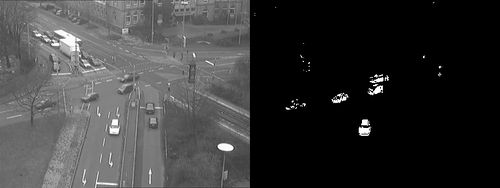Example Background Stationary Camera
From BoofCV
Jump to navigationJump to searchThe printable version is no longer supported and may have rendering errors. Please update your browser bookmarks and please use the default browser print function instead.
Example of background modeling/motion detection from a stationary camera. Moving objects are detected inside the video based on their difference from a background model. These techniques can run very fast (basic runs over 2,000 fps) and be very effective in tracking algorithms
Example File:
Concepts:
- Motion Detection
- 2D Image Stitching
Related Examples:
Example Code
/**
* Example showing how to perform background modeling when the camera is assumed to be stationary. This scenario
* can be computed much faster than the moving camera case and depending on the background model can some times produce
* reasonable results when the camera has a little bit of jitter.
*
* @author Peter Abeles
*/
public class ExampleBackgroundRemovalStationary {
public static void main( String[] args ) {
String fileName = UtilIO.pathExample("background/street_intersection.mp4");
// String fileName = UtilIO.pathExample("background/rubixfire.mp4"); // dynamic background
// String fileName = UtilIO.pathExample("background/horse_jitter.mp4"); // degraded performance because of jitter
// String fileName = UtilIO.pathExample("tracking/chipmunk.mjpeg"); // Camera moves. Stationary will fail here
// Comment/Uncomment to switch input image type
ImageType imageType = ImageType.single(GrayF32.class);
// ImageType imageType = ImageType.il(3, InterleavedF32.class);
// ImageType imageType = ImageType.il(3, InterleavedU8.class);
// ConfigBackgroundGmm configGmm = new ConfigBackgroundGmm();
// Comment/Uncomment to switch algorithms
BackgroundModelStationary background =
FactoryBackgroundModel.stationaryBasic(new ConfigBackgroundBasic(35, 0.005f), imageType);
// FactoryBackgroundModel.stationaryGmm(configGmm, imageType);
MediaManager media = DefaultMediaManager.INSTANCE;
SimpleImageSequence video =
media.openVideo(fileName, background.getImageType());
// media.openCamera(null,640,480,background.getImageType());
// Declare storage for segmented image. 1 = moving foreground and 0 = background
GrayU8 segmented = new GrayU8(video.getWidth(), video.getHeight());
var visualized = new BufferedImage(segmented.width, segmented.height, BufferedImage.TYPE_INT_RGB);
var gui = new ImageGridPanel(1, 2);
gui.setImages(visualized, visualized);
ShowImages.showWindow(gui, "Static Scene: Background Segmentation", true);
double fps = 0;
double alpha = 0.01; // smoothing factor for FPS
while (video.hasNext()) {
ImageBase input = video.next();
long before = System.nanoTime();
background.updateBackground(input, segmented);
long after = System.nanoTime();
fps = (1.0 - alpha)*fps + alpha*(1.0/((after - before)/1e9));
VisualizeBinaryData.renderBinary(segmented, false, visualized);
gui.setImage(0, 0, (BufferedImage)video.getGuiImage());
gui.setImage(0, 1, visualized);
gui.repaint();
System.out.println("FPS = " + fps);
BoofMiscOps.sleep(5);
}
System.out.println("done!");
}
}
